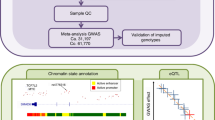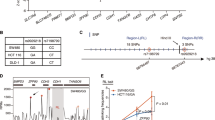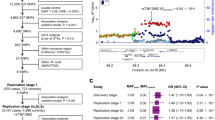Abstract
Homozygosity for the G allele of rs6983267 at 8q24 increases colorectal cancer (CRC) risk ∼1.5 fold. We report here that the risk allele G shows copy number increase during CRC development. Our computer algorithm, Enhancer Element Locator (EEL), identified an enhancer element that contains rs6983267. The element drove expression of a reporter gene in a pattern that is consistent with regulation by the key CRC pathway Wnt. rs6983267 affects a binding site for the Wnt-regulated transcription factor TCF4, with the risk allele G showing stronger binding in vitro and in vivo. Genome-wide ChIP assay revealed the element as the strongest TCF4 binding site within 1 Mb of MYC. An unambiguous correlation between rs6983267 genotype and MYC expression was not detected, and additional work is required to scrutinize all possible targets of the enhancer. Our work provides evidence that the common CRC predisposition associated with 8q24 arises from enhanced responsiveness to Wnt signaling.
This is a preview of subscription content, access via your institution
Access options
Subscribe to this journal
Receive 12 print issues and online access
$209.00 per year
only $17.42 per issue
Buy this article
- Purchase on Springer Link
- Instant access to full article PDF
Prices may be subject to local taxes which are calculated during checkout




Similar content being viewed by others
References
Couzin, J. & Kaiser, J. Genome-wide association. Closing the net on common disease genes. Science 316, 820–822 (2007).
Easton, D.F. & Eeles, R.A. Genome-wide association studies in cancer. Hum. Mol. Genet. 17, R109–R115 (2008).
Tomlinson, I. et al. A genome-wide association scan of tag SNPs identifies a susceptibility variant for colorectal cancer at 8q24.21. Nat. Genet. 39, 984–988 (2007).
Zanke, B.W. et al. Genome-wide association scan identifies a colorectal cancer susceptibility locus on chromosome 8q24. Nat. Genet. 39, 989–994 (2007).
Haiman, C.A. et al. A common genetic risk factor for colorectal and prostate cancer. Nat. Genet. 39, 954–956 (2007).
Yeager, M. et al. Genome-wide association study of prostate cancer identifies a second risk locus at 8q24. Nat. Genet. 39, 645–649 (2007).
Zheng, S.L. et al. Cumulative association of five genetic variants with prostate cancer. N. Engl. J. Med. 358, 910–919 (2008).
Gruber, S.B. et al. Genetic variation in 8q24 associated with risk of colorectal cancer. Cancer Biol. Ther. 6, 1143–1147 (2007).
Poynter, J.N. et al. Variants on 9p24 and 8q24 are associated with risk of colorectal cancer: results from the Colon Cancer Family Registry. Cancer Res. 67, 11128–11132 (2007).
Tuupanen, S. et al. Allelic imbalance at rs6983267 suggests selection of the risk allele in somatic colorectal tumor evolution. Cancer Res. 68, 14–17 (2008).
Li, L. et al. A common 8q24 variant and the risk of colon cancer: a population-based case-control study. Cancer Epidemiol. Biomarkers Prev. 17, 339–342 (2008).
Schafmayer, C. et al. Investigation of the colorectal cancer susceptibility region on chromosome 8q24.21 in a large German case-control sample. Int. J. Cancer 124, 75–80 (2009).
Berndt, S.I. et al. Pooled analysis of genetic variation at chromosome 8q24 and colorectal neoplasia risk. Hum. Mol. Genet. 17, 2665–2672 (2008).
Yeager, M. et al. Comprehensive resequence analysis of a 136 kb region of human chromosome 8q24 associated with prostate and colon cancers. Hum. Genet. 124, 161–170 (2008).
He, T.C. et al. Identification of c-MYC as a target of the APC pathway. Science 281, 1509–1512 (1998).
Bienz, M. & Clevers, H. Linking colorectal cancer to Wnt signaling. Cell 103, 311–320 (2000).
Tenesa, A. et al. Genome-wide association scan identifies a colorectal cancer susceptibility locus on 11q23 and replicates risk loci at 8q24 and 18q21. Nat. Genet. 40, 631–637 (2008).
Hallikas, O. et al. Genome-wide prediction of mammalian enhancers based on analysis of transcription-factor binding affinity. Cell 124, 47–59 (2006).
Palin, K., Taipale, J. & Ukkonen, E. Locating potential enhancer elements by comparative genomics using the EEL software. Nat. Protocols 1, 368–374 (2006).
Barrett, J.C., Fry, B., Maller, J. & Daly, M.J. Haploview: analysis and visualization of LD and haplotype maps. Bioinformatics 21, 263–265 (2005).
Lickert, H. & Kemler, R. Functional analysis of cis-regulatory elements controlling initiation and maintenance of early Cdx1 gene expression in the mouse. Dev. Dyn. 225, 216–220 (2002).
Jiang, J. & Levine, M. Binding affinities and cooperative interactions with bHLH activators delimit threshold responses to the dorsal gradient morphogen. Cell 72, 741–752 (1993).
Yochum, G.S. et al. Serial analysis of chromatin occupancy identifies β-catenin target genes in colorectal carcinoma cells. Proc. Natl. Acad. Sci. USA 104, 3324–3329 (2007).
Robertson, G. et al. Genome-wide profiles of STAT1 DNA association using chromatin immunoprecipitation and massively parallel sequencing. Nat. Methods 4, 651–657 (2007).
Heintzman, N.D. et al. Distinct and predictive chromatin signatures of transcriptional promoters and enhancers in the human genome. Nat. Genet. 39, 311–318 (2007).
Barrow, J.R. et al. Ectodermal Wnt3/β-catenin signalling is required for the establishment and maintenance of the apical ectodermal ridge. Genes Dev. 17, 394–409 (2003).
Huelsken, J. et al. Requirement for β-catenin in anterior-posterior axis formation in mice. J. Cell Biol. 148, 567–578 (2000).
Houlston, R.S. et al. Meta-analysis of genome-wide association data identifies four new susceptibility loci for colorectal cancer. Nat. Genet. 40, 1426–1435 (2008).
Broderick, P. et al. A genome-wide association study shows that common alleles of SMAD7 influence colorectal cancer risk. Nat. Genet. 39, 1315–1317 (2007).
Jaeger, E. et al. Common genetic variants at the CRAC1 (HMPS) locus on chromosome 15q13.3 influence colorectal cancer risk. Nat. Genet. 40, 26–28 (2008).
Tomlinson, I.P. et al. A genome-wide association study identifies colorectal cancer susceptibility loci on chromosomes 10p14 and 8q23.3. Nat. Genet. 40, 623–630 (2008).
Kiemeney, L.A. et al. Sequence variant on 8q24 confers susceptibility to urinary bladder cancer. Nat. Genet. 40, 1307–1312 (2008).
Pomerantz, M.M. et al. The 8q24 cancer risk variant rs6983267 demonstrates long-range interaction with MYC in colorectal cancer. Nat. Genet. advance online publication, doi:10.1038/ng.403 (28 June 2009).
Korinek, V. et al. Constitutive transcriptional activation by a β-catenin-Tcf complex in APC−/− colon carcinoma. Science 275, 1784–1787 (1997).
Sansom, O.J. et al. Myc deletion rescues Apc deficiency in the small intestine. Nature 446, 676–679 (2007).
Herbst, A. & Kolligs, F.T. Wnt signaling as a therapeutic target for cancer. Methods Mol. Biol. 361, 63–91 (2007).
Soucek, L. et al. Modelling Myc inhibition as a cancer therapy. Nature 455, 679–683 (2008).
Van der Flier, L.G. et al. The intestinal Wnt/TCF signature. Gastroenterology 132, 628–635 (2007).
Otero, J.J., Fu, W., Kan, L., Cuadra, A.E. & Kessler, J.A. β-catenin signaling is required for neural differentiation of embryonic stem cells. Development 131, 3545–3557 (2004).
Miller, C. & Sassoon, D.A. Wnt-7a maintains appropriate uterine patterning during the delopment of the mouse female reproductive tract. Development 125, 3201–3211 (1998).
Lei, Q. et al. Wnt signaling inhibitors regulate the transcriptional response to morphogenetic Shh-Gli signaling in the neural tube. Dev. Cell 11, 325–337 (2006).
Kioussi, C. et al. Identification of a Wnt/Dvl/β-catenin → Pitx2 pathway mediating cell-type-specific proliferation during development. Cell 111, 673–685 (2002).
Aaltonen, L.A. et al. Incidence of hereditary nonpolyposis colorectal cancer and the feasibility of molecular screening for the disease. N. Engl. J. Med. 338, 1481–1487 (1998).
Salovaara, R. et al. Population-based molecular detection of hereditary nonpolyposis colorectal cancer. J. Clin. Oncol. 18, 2193–2200 (2000).
Badis, G. et al. Diversity and complexity in DNA recognition by transcription factors. Science advance online publication, doi:10.1126/science.1162327 (14 May 2009).
Hallikas, O. & Taipale, J. High-throughput assay for determining specificity and affinity of protein-DNA binding interactions. Nat. Protoc. 1, 215–222 (2006).
Taipale, J., Cooper, M.K., Maiti, T. & Beachy, P.A. Patched acts catalytically to suppress the activity of Smoothened. Nature 418, 892–897 (2002).
Turunen, M.M., Dunlop, T.W., Carlberg, C. & Väisanen, S. Selective use of multiple vitamin D response elements underlies the 1α,25-dihydroxyvitamin D3-mediated negative regulation of the human CYP27B1 gene. Nucleic Acids Res. 35, 2734–2747 (2007).
Audic, S. & Claverie, J.M. The significance of digital gene expression profiles. Genome Res. 7, 986–995 (1997).
Kwan, T. et al. Genome-wide analysis of transcript isoform variation in humans. Nat. Genet. 40, 225–231 (2008).
The International HapMap Consortium. The International HapMap Project. Nature 426, 789–796 (2003).
Smyth, G.K. in Bioinformatics and Computional Biology Solutions using R and Bioconductor (ed. Gentleman. R.) Limma:linear models for microarray data (Springer, New York, 2005).
Laiho, P. et al. Serrated carcinomas form a subclass of colorectal cancer with distinct molecular basis. Oncogene 26, 312–320 (2007).
Dai, M. et al. Evolving gene/transcript definitions significantly alter the interpretation of GeneChip data. Nucleic Acids Res. 33, e175 (2005).
Acknowledgements
This work was supported by the grants from Academy of Finland (Finnish Center of Excellence Program 2006-2011), the Finnish Cancer Society, the Sigrid Juselius Foundation, the European Commission (LSHG-CT-2004-512142) and by grants to S.T. (Ida Montin Foundation, Biomedicum Helsinki Foundation, Paulo Foundation, Mary and Georg C. Ehrnrooth Foundation and Maud Kuistila Foundation). The work of R.S.H. and I.T. is supported by Cancer Research UK. We thank A. Syvänen from the Uppsala University SNP Platform and O. Monni from the University of Helsinki for Illumina Genome-analyzer sequencing, G. Yochum for control primer sequences for TCF4, and S. Marttinen, K. Pylvänäinen, T. Lehtinen, S. Miettinen, M. Kuris, M. Aho and I. Svedberg for technical assistance. L. Peltonen (National Public Health Institute) and the Nordic Center of Excellence in Disease Genetics provided the Finnish control SNP data.
Author information
Authors and Affiliations
Contributions
The study was designed and financial support was obtained by L.A.A. and J.T. The manuscript was drafted by L.A.A., J.T. and S.T. Wet-lab experiments were performed by S.T., M.T., O.H., M.B., G.W., J.Y. and I.N. M.D.-B., I.T. and R.S.H. provided the imputed SNP data. J.-P.M. and H.J. provided the Finnish CRC specimens, A.R. contributed to histopathological evaluation of materials. R.L., S.V., T.K., P.E., L.C.-C., K.P. and A.K. performed the computational and statistical analyses. K.P., E.U. and S.T. performed the EEL analyses.
Corresponding authors
Supplementary information
Supplementary Text and Figures
Supplementary Figures 1–5, Supplementary Tables 1 and 2 and Supplementary Note (PDF 520 kb)
Rights and permissions
About this article
Cite this article
Tuupanen, S., Turunen, M., Lehtonen, R. et al. The common colorectal cancer predisposition SNP rs6983267 at chromosome 8q24 confers potential to enhanced Wnt signaling. Nat Genet 41, 885–890 (2009). https://doi.org/10.1038/ng.406
Received:
Accepted:
Published:
Issue Date:
DOI: https://doi.org/10.1038/ng.406
This article is cited by
-
Salicylate induces AMPK and inhibits c-MYC to activate a NRF2/ARE/miR-34a/b/c cascade resulting in suppression of colorectal cancer metastasis
Cell Death & Disease (2023)
-
Long non-coding RNA profile study identifies a metabolism-related signature for colorectal cancer
Molecular Medicine (2021)
-
Enhancer-derived long non-coding RNAs CCAT1 and CCAT2 at rs6983267 has limited predictability for early stage colorectal carcinoma metastasis
Scientific Reports (2021)
-
Investigating the association between rs6983267 polymorphism and susceptibility to gastrointestinal cancers in Iranian population
Molecular Biology Reports (2021)
-
An integrated analysis of public genomic data unveils a possible functional mechanism of psoriasis risk via a long-range ERRFI1 enhancer
BMC Medical Genomics (2020)



